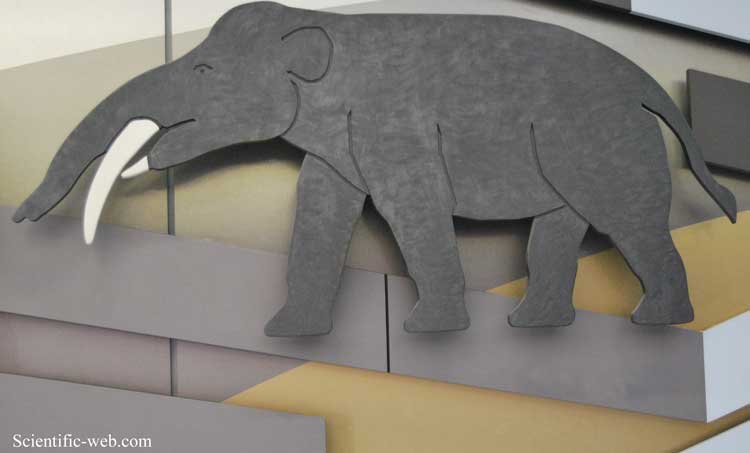
Tetralophodon sp. , Photo: Michael Lahanas
Cladus: Eukaryota
Supergroup: Opisthokonta
Regnum: Animalia
Subregnum: Eumetazoa
Cladus: Bilateria
Cladus: Nephrozoa
Cladus: Deuterostomia
Phylum: Chordata
Subphylum: Vertebrata
Infraphylum: Gnathostomata
Superclassis: Tetrapoda
Classis: Mammalia
Subclassis: Theria
Infraclassis: Placentalia
Superordo: Afrotheria
Cladus: Paenungulata
Ordo: Proboscidea
Familia: Elephantidae
Genus: †Tetralophodon
---------
Tetralophodon ("four-ridged tooth") is an extinct gomphothere genus (family Gomphotheriidae). Like typical gomphotheres, Tetralophodon had four tusks and a trunk. This genus of animals stood about ten feet tall and was a very widespread and successful proboscidean. Tetralophodon lived through the Miocene and Pliocene epoches. These animals have been found in North America, Europe, Asia, and Africa. The member species are T. longirostris, T. fricki, T. atticus, and T. punjabensis.
Description
Tetralophodon was an elephant like animal which existed in the Miocene and Pliocene eras, approximately 2 5 million years ago. The majority of the gomphotheres went extinct at the end of the Pleistocene era, during what has been named the PT extinction. While the reason for this extinction is still debated, what is known is that these massive elephantoids under the genus Tetralophodon did not survive.
Ancestral Features
Named for its four-ridged tooth, the teeth on these animals are approximately 60 x 80 mm, about 6 times the size of a normal human tooth. These low-crowned, bunodont teeth are designed for crushing and grinding, compared with other mammals during this era that had sharp teeth used for cutting. The teeth of the tetralophodon indicate a diet of large fruits and vegetables. This diet is aided by the large size and long trunks of the elephantiods that enable these mammals to reach tall, fruit-bearing trees.
Fossil records
Most fossil records of tetralophodon are of four-ridged teeth. Their body is believed to be about 10 feet tall, with a long trunk and incisors ranging up to 6.5 feet long. These incisors are believed to be utilized as a defense mechanism. Most fossils of tetralophodon have been found in South America and Europe. The name "tetralophodon" was described in the mid 1800s with the discovery of the specialized teeth. It is believed to be that the tetralophodon is an ancestor to the common elephants of today that are called mastodons.
See also
* Gomphotherium
* Rhynchotherium
Paleontology portal
References
http://www.rolandjuvyns.com/detail.asp?id=371
http://esciencenews.com/sources/scientific.blogging/2009/08/20/tetralophodon.tangier.unearthed
Ugan, Andrew and David Byers. "Geographic and temporal trends in proboscidean and human radiocarbon histories during the late Pleistocene." Quaternary Science Reviews. Dec 2007. Vol 26 Issue 25-28.
http://www.adias-uae.com/stegotetrabelodon.html#tetralophodon
http://www.paleodb.org/cgi-bin/bridge.pl?action=checkTaxonInfo&taxon_no=43261&is_real_user=0
Ehleringer, James R. et. all. "A History of Atmospheric CO2 and Its Effects on Plants, Animals and Ecosystems."
Retrieved from "http://en.wikipedia.org/"
All text is available under the terms of the GNU Free Documentation License

